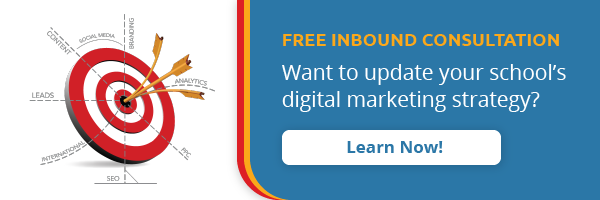
The age of overly promotional, sales-oriented marketing is long gone. When looking for a school, students want authentic advice, helpful resources, and to feel confident that the institution they’ve selected is the right one.
Inbound marketing helps maximize results in student recruitment by focusing on building trust between prospective students and schools, and offering helpful, relevant information at every step in the admissions process.
The inbound methodology certainly isn’t a new concept – in fact, Elias St. Elmo Lewis laid the foundation for it when he invented the purchase funnel way back in 1898. However, as algorithms change, new trends emerge, and social media channels evolve, the best ways for schools to target prospective students through inbound changes, too.
Whether your school has just started to experiment with inbound, or you’re looking to update your current tactics, read on to find out how to make your school’s inbound marketing strategy the best it can be today.

From Funnel to Flywheel: How Inbound Marketing for Schools has Evolved
As HubSpot says, inbound marketing is all about “attracting the right people and making a positive impact on them. Which in turn makes them want to trust your brand and spread the word about it.”
For schools, inbound is a win-win marketing strategy. By providing those researching your programs and courses with the most helpful, relevant, and informative resources and support, you give them all the tools needed to make their decision, while also improving your chances of getting results.
Even if you’re already familiar with inbound, refreshing yourself on its core objectives from time to time will help to ground and realign your strategy. The following image outlines the key goals of the inbound approach as it applies to schools:

Over time, inbound marketers have developed different models to outline the steps businesses can take to meet these goals. If you’ve been using the inbound methodology for some time, you may be familiar with its previous iteration: the “funnel.” In this descriptive model, an organization’s marketing department attempts to reach a wide audience with its campaigns, and leads are followed up with by the sales team (or admissions team, in the case of schools). Those who are still there at the end of this process – or the “bottom” of the funnel – are your students.

In the funnel model, however, your students are in danger of being treated as an afterthought. Once they’ve reached the end of the funnel, their journey is complete.
This inherent flaw is particularly apparent in the education sector, but can be seen in the application of the funnel across all industries. While this model was successful in an era where product quality drove sales, it doesn’t correspond well with current consumer behavior, which favours customer experience.
As a result, marketers have recently adopted the “flywheel” model, which places customers at the centre. In this model, businesses aim to attract their target audience, engage them with helpful content, and delight them so much through the process that they tell others about their experience.
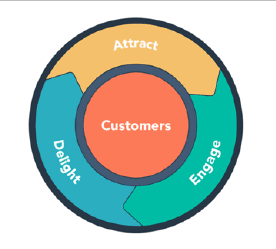
Source: HubSpot
Notice how, in contrast to the funnel, there’s no endpoint to the flywheel. This is because word of mouth promotion is more important than ever – in fact, it’s the source that consumers trust the most – so what happens after someone makes a sale is almost as important as the sale itself.
By keeping the flywheel in mind when developing your school’s inbound marketing strategy you can shift its focus towards creating authentic connections with prospects that will grow throughout the admissions process and beyond. In doing so, you’ll generate positive feedback and enhance your reputation to attract new prospects organically, and keep the flywheel spinning.
The Attract Stage: Helping Prospective Students Find You
To initiate the inbound flywheel, your school needs to attract prospective students by providing them with the information and resources they need, in the most enjoyable way possible.
For schools, the key to success in the first inbound stage is twofold: maximize your online presence so prospective students can easily find your school, and create winning content to hook their attention once they’ve found you.
By understanding who your prospects are, strategically creating content based on those personas, and optimizing your channels to be as visible as possible, you’re setting your school up for inbound success.
Defining and Updating Your Student Personas
Personas are a great way to create a clear picture of the prospective students you hope to attract.
The more relevant details you add to them, the more you can refine your marketing efforts for your target audience. Unfortunately, many schools only use a few basic details to create each persona, while some don’t even clearly define them at all.
Through qualitative research and quantitative tools, however, schools can create more robust student personas.
Your team will likely have a good idea of who your prospective students are already – it just takes some extra research to identify the key factors that typically influence a prospect’s decision to attend your school.
The Buyer Persona Institute suggests addressing the following 5 factors when creating personas: priority initiatives, success factors, perceived barriers, the buyer’s journey, and decision criteria. Schools can adapt these elements to their personas by answering the following questions:
- What are their education goals?
- What may stop them from choosing your school?
- What steps will they take in their decision-making journey (i.e. where will they look online while researching schools? Are they going to want to speak to admissions staff? Will they attend events?)
- What key demographic categories (such as age, location, current level of education, professional status, parental status, etc.) does the persona fit into?
- Who, or what, influences them to make education-related decisions?
To take your personas a step further, supplement or validate your answers to these questions with quantitative data. Through your online data sources, your school can ensure your personas are as accurate as possible.
Google Analytics is a useful tool for obtaining persona information, as you can see where people viewing your website are located, as well as their age and gender. You can also check out “Interest Reports” which, as the name suggests, let you see what other websites visitors are interested in based on their online behavior. These reports can give you a better idea of what programs may appeal to a particular prospect, allowing you to further personalize your inbound marketing efforts.
Example: Interest reports in GA for an education institution. You can see more general interests and lifestyle information in the Affinity Category report, while the In-Market Segment report identifies users who are actively searching and comparing products or services in your industry. Can you guess what kind of school this is?

With this information, you can create the most robust, detail-rich personas possible, whilst knowing that the extra info you’ve added is as accurate as it can be.
Another way to ensure the accuracy of your personas is to put your data to the test by surveying your prospective, current, and past students.
SurveyMonkey, Typeform, PollDaddy, and Google Forms are popular platforms you can use to create simple surveys to present to your audience on social media, at webinars, or through email marketing campaigns.
Example: SurveyMonkey has a preset “Admissions Satisfaction Survey” that schools can use.
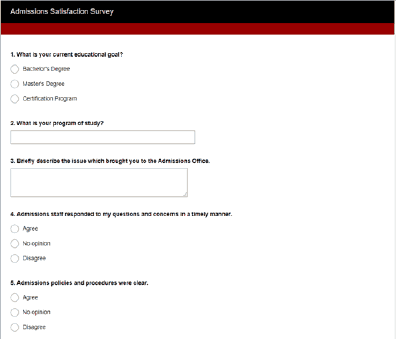
Without understanding your prospective students, you won’t know what tools and methods to use to attract them. Through qualitative analysis, quantitative data, and surveys, you can create a solid foundation upon which to build a comprehensive, targeted inbound marketing strategy.
Improve Your School’s SEO through Content Clusters
Once you have an idea of who you are seeking to attract, the next step is to make your school as visible as possible to this audience. How you rank on Google search is a crucial online visibility indicator – but the factors that influence this ranking continuously change.
Appearing on the first page of Google is no longer about the specific keywords you use, but about establishing your website as an online authority on a particular subject. By creating clusters of content around topics, you demonstrate your expertise in that category, and search engines boost your online presence accordingly.
Schools can begin to adopt the “cluster content” approach by first identifying which pages on their website are “pillar pages.” A pillar page is a single page that offers a general overview of all aspects of a particular topic. (If you don’t think you have any pillar pages, perhaps now’s the time to pencil them into your blog calendar). Then, link related content on specific subtopics – aka cluster content – to your pillar pages. Below, you can see different examples of blog posts that could link back to a central pillar page.

As you develop your content marketing strategy, consider which pillar pages could be useful for your school, and what supplementary content would connect well to it. After all, even one high performing cluster page can raise search engine rankings for all the other pages linked to the same topic.
Develop a Multi-Channel, Multi-Feature Social Media Strategy
Social media users want to see lively, engaging content. If their newsfeed scroll is constantly interrupted by overly promotional posts, they’ll find another platform. As a result, social media channels are constantly adding exciting, interactive features to their platforms to retain user interest.
Stories is one format that caters perfectly to this need, allowing your school to assemble unique creations that incorporate short video content, customized text, fun stickers, filters, and other features. As a result, stories have taken the social media game by storm since Snapchat introduced them in 2016.
Example: ELC Sydney uses the Questions Instagram Story sticker to engage with current and prospective students alike in a fun, conversational way through their stories.

Livestreaming can also help you take user retention to the next level by creating a sense that viewers are part of what’s taking place on screen. By watching action unfold in real time, and having the option to react and comment as you watch, livestreaming mimics real-life participation in fun events. For schools, livestreaming is a great way to give students a real-life sense of your school – or as close to that as possible.
Example: Queen’s University streamed their “Ask an Astronaut” Q&A via Facebook Live to enable people to chime in with questions remotely.

The more unique and dynamic your content is, and the more relevant it is to your prospects, the more attractive your school becomes in the eyes of a prospective student. With an effective inbound marketing strategy, your school can ensure that it is both visible to as many of your target audience as possible, and has effective tools to draw those prospects in.
The Engage Stage: Directly Connect with Prospects
Let’s say someone visits your website after reading an Instagram post, or comes across your school’s site after Googling “Top UK Language Schools.” What’s next? After attracting prospective students, the second stage of inbound marketing for schools is where you directly engage with them. Here, you initiate conversation with prospects, inviting them to learn more about you, while gently leading them on the path towards application.
Optimize Your Website for Conversions
Once you’ve piqued the interest of a potential student, don’t lose them when they land on your website. Today’s students can have higher expectations when browsing the web. Even small snags like having difficulties finding admissions deadlines or information specific to international students can alter a prospect’s view of your school.
On the flipside, the easier it is for prospects to navigate your website, the more likely they are to submit inquiries and applications. Designing your website for user experience and conversion optimization makes it as easy as possible for students to engage with your school online, and naturally move towards making an inquiry as they learn more about what you have to offer.
Example: The homepage of Herzing College uses eye-catching visuals to easily allow you to see the different programs it offers.
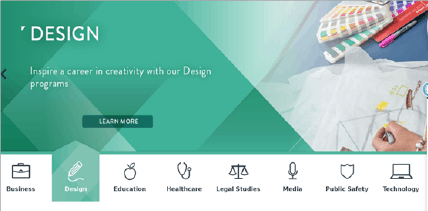
There are many ways your school can update its website to provide optimum user experience for students. Here are a few pointers from TechWyse:
- Clearly define your pages and their purpose
- Use headers/images for clarity and categorization
- Interlink to other pages when further resources are needed
- Break up text with bullet points
- Ask for feedback on user experience
One way to optimize your website for conversions is by placing CTAs (calls to action) and forms strategically throughout your site. These assets make it easy to direct prospects to helpful resources, capture their contact information, and ultimately move them along the flywheel towards conversion.
CTAs and forms are an extremely effective way of capturing qualified leads. Whether you create a form at the bottom of a blog post that allows readers to sign up for your newsletter, or add a CTA that links to a webinar landing page, you’re further connecting prospects to your school at their request, meaning they are more likely to engage with the content you offer.
Example: The moment someone lands on Herzing College’s website, a popup appears with numerous CTA buttons that allow prospects to ‘request more info,’ ‘book a campus tour,’ ‘start a live chat,’ or ‘take our career training readiness quiz’ with the click of a button.
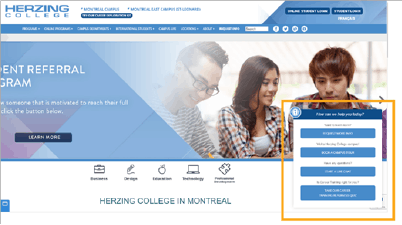
While CTAs direct prospects to key pages, forms enable you to collect information.
Example: On John Cabot University’s homepage, you can request information by providing your contact details. When it comes to marketing, this is worth its weight in gold. A phone number and email will allow you to follow up with prospects through email, SMS, or by phone. A prospect’s name, country, and program of interest allow you to personalize that follow-up message. Finally, the semester and year of interest indicate when you should be following up with that student.

If your school’s website is designed with user experience in mind, students can easily find the information they need – and if you’ve also optimized your site for conversions, your team will get the information you need from prospects, as well.
Adopt an Inbound Approach towards Marketing Automation
Once an inquiry has been made, following up on it is crucial. Through marketing automation software, you can customize your follow-up with prospects based on factors such as their persona, online behavior, and what stage they are at in the admissions journey.
Marketing automation systems allow you to streamline various marketing tasks and make it easier to reach a larger number of people in a more personalized way. From automated workflows for email campaigns to SMS lead nurturing, there are many ways to use marketing automation software to meet inbound objectives. Some systems also make it easier to create customized CTAs, forms, pop-ups, and other engaging web elements.
By personalizing your interactions with prospects, you demonstrate that you understand the needs of future students. In turn, they are more likely to trust your school as a result. Instead of bombarding all your leads with the same emails, for example, anticipate the content certain segments are most likely to engage with and ensure that’s what they see in their inbox.
With the ability to connect with all prospects in many ways with the click of a button, it’s tempting to overuse the tools of marketing automation. But doing so actually deters prospects from your school by creating the impression that you’re more eager to make a sale than help a student. Instead of using marketing automation as a method of mass communication, use it as a tool of strategic interaction. If you do that, the potential possibilities are endless.
Make Use of Automated Workflows for your Email Campaigns
With 76% of students preferring to communicate with schools via email, it’s worth devoting particular attention to the channel at this stage of the enrollment journey.
Through automated email workflows, your school can nurture leads by sharing useful content, directing them to key resources, and gently moving them along the path to enrollment.
Once a prospective student performs a certain action – like completing an inquiry form or downloading content from your website – a specific workflow can be triggered, and a strategic sequence of emails will be sent over a set timeframe.
The workflow below aims to increase engagement with each email, inviting students to first check out courses and programs and later to speak directly with an admissions officer.

You can also further customize your workflows by segmenting leads based on the program they are interested in, their location, or other persona-specific attributes, and send along emails specific to their needs.
Follow up with Leads Through SMS and Instant Messaging
While email remains one of the most vital tools for any marketing campaign, your school could also benefit from using SMS and instant messaging to reach prospective students. Both tools have impressive open rates – SMS marketing and WhatsApp have a 98% and 70% open rate, respectively, while the standard email open rate is 18%.
Whether you’re texting a prospect or using a messaging app, these two direct communication channels have endless recruitment possibilities, including:
- Sending timely reminders of approaching admissions deadlines
- Sharing helpful resources and links
- Enabling students to text in questions
- Checking in with prospects throughout the admissions journey
- Asking applicants to fill out feedback surveys
Example: In this mock-up, you can see how quick, direct, and easy it is to send a simple reminder to a prospective student.
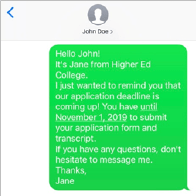
Whether your team decides to use SMS, instant messaging, or both in a given marketing campaign will largely depend on your target persona. Instant messaging, for example, is a great option for schools looking to communicate with students overseas because you can avoid long distance SMS fees. Many schools will use platforms like WhatsApp, Messenger and even WeChat for this purpose.
Whether you’re using SMS or a messaging app, sending out mass messages and keeping track of responses manually is challenging and time-consuming. Thankfully, some CRM and marketing automation platforms allow you to easily organize your SMS and IM campaigns and keep track of your conversations.
Example: There are many marketing automation software options to help streamline your SMS or instant messaging campaigns. HEM’s customized Mautic platform, for example, allows you to send and receive texts directly from the system to your contacts.
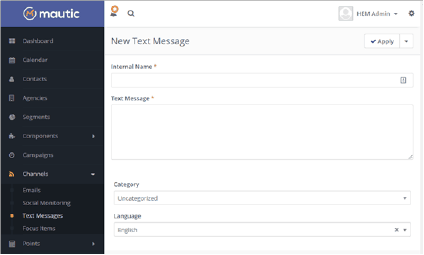
Inbound marketing is all about using today’s tools to meet prospects where they’re at. Considering that SMS and instant messaging are primary communication channels for so many people, they are perfect tools your school can use to reach its target audience.
From direct messaging to emails to CTAs, the engage stage of the inbound process initiates meaningful interaction between prospects and schools. With a well-designed website, it’s easy for students to reach out to your school – and through streamlined communication, it’s easier for your school to follow up.
The Delight Stage: Bringing Your School’s Inbound Marketing Strategy Full Circle
Positive customer experience is what propels the inbound flywheel towards long-term success. If you adopt an inbound mindset, your goal should not simply be to increase the number of inquiries and applications your school receives. Instead, you should strive to provide prospects with the best possible experience.
If you take this approach, you’re bound to not only raise your application rate in the short term, but multiply it in the long term, as you delight students so much that they spread the word about your school.
Example: Imagine this: after receiving quality guidance from admissions staff, and being guided along the application process, an incoming student is so excited about attending your school that they share their joy with others, as one future Guelph student did below.

Since people are 90% more likely to trust a brand a peer recommends, the extra effort you put into creating a helpful, personalized marketing strategy will be well worth the word-of-mouth promotion that it produces.
Keep Learning From Your Students Through Data & Insights
In order to consistently delight prospects, your school must continuously update and improve its recruitment approach.
Monitoring and evaluating your campaigns allows you to identify the areas you need to improve. By viewing your search engine ranking and how much traffic your site has, you can evaluate how well you’ve attracted prospects. Activity on your website, social media channels, and email indicates your engagement levels. Last, but certainly not least, you can track the overall effectiveness of your inbound strategy by looking at the number of inquiries and applications you receive.
Tools like Google Analytics, Search Console, and your CRM reports make it easy to see your campaign performance and drill down into the data to gain actionable insights.
Example: In this Google Analytics Channel Report, the majority of this school’s traffic is coming from organic search, indicating that its performance on that channel is particularly strong. Interestingly, though, you can also see that the goal conversion rate on social is much higher than on other channels, despite it comprising a small portion of the overall completions, suggesting some untapped potential.

Inbound marketing strategies for schools shouldn’t be static, they should change with your audience’s behavior and the evolution of online trends and features. In order to meet inbound objectives in the most efficient way possible, it’s crucial to continuously monitor each element of your marketing campaign.
Use Reviews as a Tool of Improvement
With online reviews swaying the purchasing decisions of 93% of consumers, schools must pay close attention to the feedback they receive on channels like Google My Business, Yelp, and Facebook. Reviews are a key part of the delight stage as they can either improve your brand’s reputation through positive word-of-mouth advertising, or tarnish it through negative responses. As a result, many see reviews as either a best friend or worst enemy – but with the following tips, your school can transform digital review platforms into a site of opportunity:
1. Respond to reviews quickly. According to a recent ReviewTrackers survey, “53% of people expect businesses to respond to negative reviews within a week”.
2. Thank those who write positive reviews. This will encourage others to do the same if they know you pay attention to them.
3. Handle negative reviews with grace. Apologize when necessary, offer resources, and provide contact information to ensure their grievance is dealt with.
4. Encourage people to leave reviews by reaching out to alumni and periodically making reference to reviews on your social media channels.
While reviews may have an impact on your school’s reputation, the opinions of your prospective, current, and former students are even more important. When going through your reviews, it’s also important to adopt an inbound mindset. Since your school should be continuously striving to provide a better experience to prospects, listen to what students have to say, and strategize ways you can meet their demand.
For schools, inbound marketing involves going above and beyond to give your future students the best admissions experience possible – but it doesn’t end there. Your efforts to directly connect with prospects in a personalized, helpful way shouldn’t finish when they submit their application. Continue to cultivate the relationships you’ve built with your current students, your alumni, their families, and other members of your online community. The positive experience they have will benefit both them and you in the long run.
